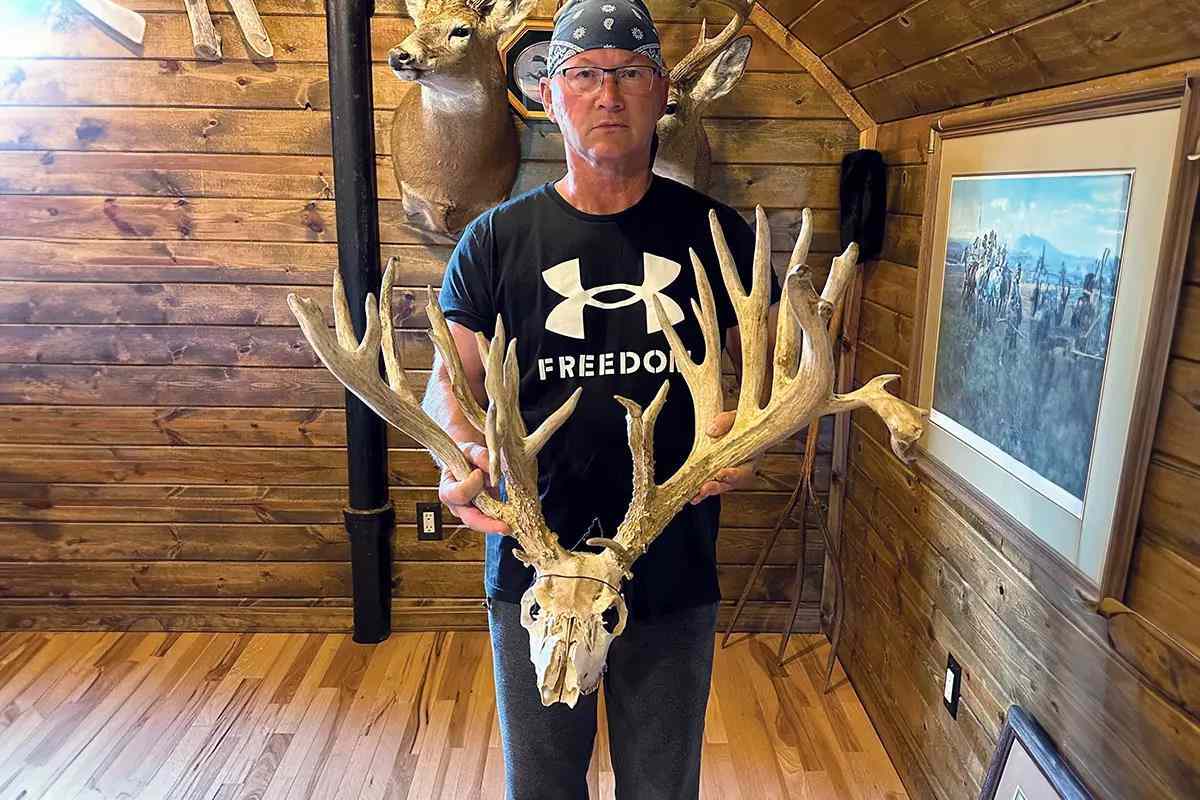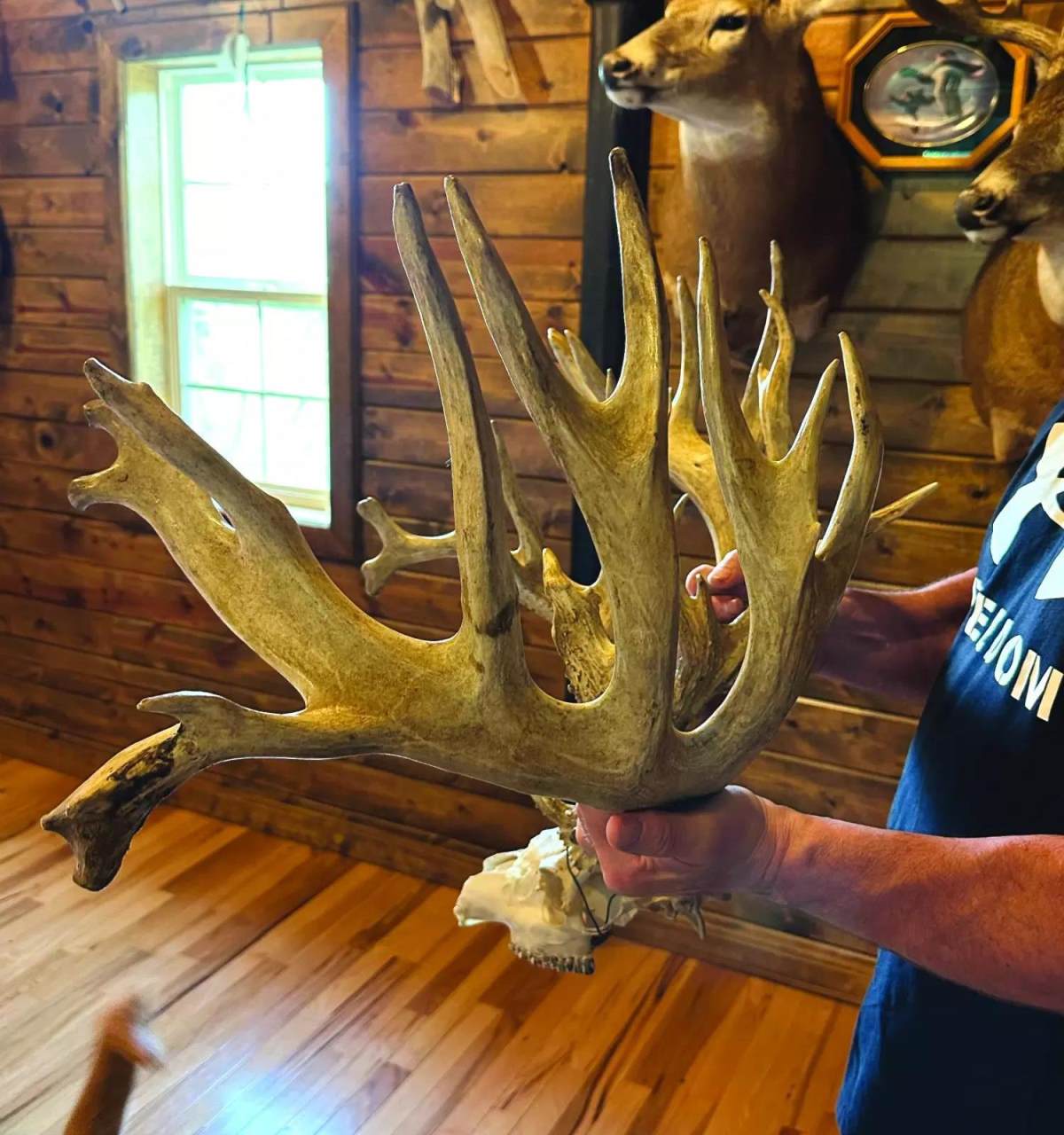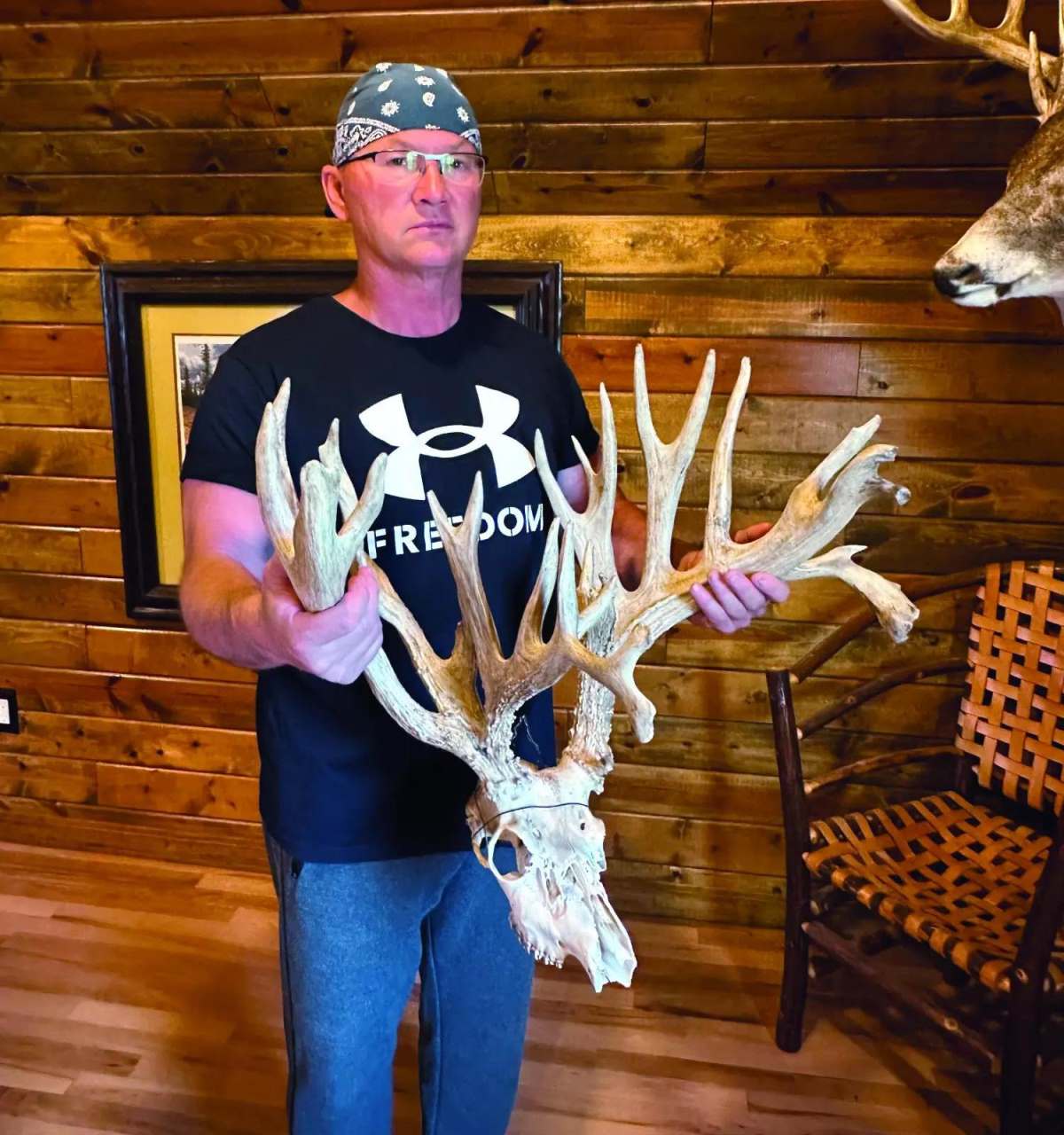
North Dakota antler collector Bernie Knutson holds the unbelievable non-typical rack and skull he purchased from Rob Turner. Photo courtesy of Bernie Knutson
In the early to mid 1900s, deer hunting was a far different experience from what most of us know now. Hunters wore clothing and used transportation and gear which seems very primitive compared to what we have today. Lever-action rifles, Winchester 94s and Savage 99s, chambered in calibers long gone and without scopes were very popular. There were no manufactured tree stands, and individual still-hunts or group man drives were the tactics most often used.
The tremendous population of whitetail deer we enjoy would have been something they could not have imagined. Whitetails were only where you could find them. You might walk miles in pursuit, and then have a hefty drag back to camp. It was sport, for sure! But getting venison to sustain a family was also real work. Most certainly, there were some bragging rights involved, though the focus was not on trophy bucks.
At North American Whitetail, we hear of hundreds of giant bucks taken each season. We cover dozens in the magazine annually, and many more online in our Breaking News Bucks campaign. And once in a while, we discover one from the past with a great tale to pass along. Bernie Knutson, who lives in North Dakota, is known for collecting antlers and hunting big bucks. He reached out recently with an intriguing story of a huge Michigan non-typical; one that had been unknown to the whitetail world. How did a huge head from the Great Lakes State end up way out there? And how had it been such a secret for so long? We had to know…

“One day, I left my shop to get some parts,” he relays. “When I returned, my cousin told me a guy had stopped by with a big rack. When I asked how big the rack was, he said ‘REAL BIG!’” Since the mystery man had already left with the antlers, Bernie just shrugged his shoulders and went back to work. “Two weeks later, I drove up to the shop and spotted a truck I didn’t recognize,” he recalls. “And as I walked by, the whole front seat appeared to be filled with antlers. I took one look and asked, ‘How much?’” It didn’t take long to come to an agreement, and the huge rack changed hands. “I was not letting this one get away,” Bernie smiles. And after the sale, Rob Turner, who sold the rack, filled in interesting details about the history of the antlers.
Here’s what we know now. The giant was killed by Rob’s grandfather, C. R. Turner, sometime in the 1940s, in Ontonagon County, Michigan, at a very remote deer camp. Mr. Turner, and his hunting buddies, made many trips to those isolated woods over the course of several decades. “My dad was in the service, over in Europe during World War II, when my grandfather killed this buck,” Rob states. “That is as close as I can pinpoint when he took it.

“I never got to hunt with him, and my dad was not a hunter,” Rob adds. “But I listened to many tales during fishing trips as I was growing up.” Each fall in mid-November, Rob’s grandfather and his group of friends would pack up provisions and drive their automobiles north, to a point where the road ended. From there, a local using a horse drawn sled would transport them many more miles, until they reached the hunting woods, very near Lake Superior. There they would remain until the hunt ended, without benefit of electricity, telephone service, or any other modern conveniences. Primitive hunting at its finest!
Very few pictures of life at that camp exist. But upon examination they reveal plaid wool, knee high laced leather boots, plenty of snow, and a game pole sagging from the weight of numerous bucks. Fall after fall, even during the war years, deer season and traditions carried on. Strapping big bucks to automobile fenders was a very real thing…
On one trip, tragedy struck! One of the men in the party passed away suddenly, from a presumed heart attack. And with no way to notify the family, or get to any outside help, the remaining hunters had the gruesome task of deciding how to handle preserving the body, and keeping it safe from wild animals, until the sled returned. The simplest solution: Bundle it up and hang it from the game pole. That apparently worked very well in below-freezing temperatures, and the hunt went on as planned.
When populations are low, the potential to produce giant antlers can increase through lack of competition for available food. Add in a remote region, along with light hunting pressure, and you might find yourself with real trophy potential. The Upper Peninsula fit that description perfectly back then. And Mr. Turner did well in his years of hunting at their camp, shooting some great bucks. Although he never got any of them measured, he kept the antlers displayed in his house. Taxidermy being what it was at the time, he simply cut most of the antlers off at the base or skull plate, or he’d keep the skull. And that was that.
Rob was gifted some of the better trophy deer heads when he was a young man, including a 10-point with awesome double drop tines. That rack spans an amazing 30 inches to the outside of the drops. Rob got that one mounted, and it now hangs in a nephew’s house. He also had another big non-typical that took a bad fall, breaking the rack to the point where he felt it was ruined. “I was so disgusted that I threw it into the trash!” he reports.
After his grandfather passed, Rob received a treasured collection of old shotguns and rifles, and old hunting licenses and tags, dating back to 1917. Everyone in the family knew about most of that collection. But a real surprise came later, when a giant non-typical rack was discovered stored away in the attic. The huge head has a broken wire attached, which once held it up on the wall. Apparently, it was put away for all the years, in lieu of making the repair. That time in the attic did no harm, and it has obviously aged very well.

The rack features a prominent extra beam on the right side, split points on all three beams, and 102 inches of abnormal points. The Michigan state non-typical whitetail record was killed in 1976, and currently holds that spot with a net score of 238 2/8. The Turner deer unofficially green scores 267 2/8, with a net score of 237 7/8, missing surpassing the record by an incredibly small margin. We reached out to Commemorative Bucks of Michigan, the official record keeper for the state. They were extremely interested and outlined the procedure for getting the buck entered into their records. That will require panel scoring to certify a buck into one of the top three spots, which is almost a certainty.
That also leaves the door open for this deer to be the new state record if the panel can find just a bit more antler on the complicated frame. The county record is much lower, so it will easily claim that title. Curiously, the top three bucks from Octonagon County all came from the early part of the 1900s, too! Mr. Turner, and his friends, had been there all through prime time.
When this head will be officially measured and claim the top spot in the state, or somewhere very near that mark, remains unknown, for now. Either way, it certainly deserves recognition. And you saw it first at North American Whitetail!








